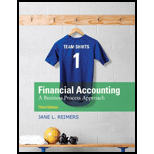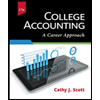
Financial Accounting
3rd Edition
ISBN: 9780133791129
Author: Jane L. Reimers
Publisher: Pearson Higher Ed
expand_more
expand_more
format_list_bulleted
Question
Chapter 4, Problem 5YT
To determine
State the way note and any related interest will be reported on the balance of the Company D on December 31.
Expert Solution & Answer
Want to see the full answer?
Check out a sample textbook solution
Students have asked these similar questions
Can you help me solve this financial accounting question using valid financial accounting techniques?
Hello tutor please provide correct answer general accounting question with correct solution do fast
Can you solve this general accounting problem using appropriate accounting principles?
Chapter 4 Solutions
Financial Accounting
Ch. 4 - Prob. 1YTCh. 4 - Prob. 2YTCh. 4 - Suppose at the end of the year Pendleton Corp.s...Ch. 4 - Prob. 4YTCh. 4 - Prob. 5YTCh. 4 - Prob. 6YTCh. 4 - Prob. 7YTCh. 4 - Prob. 1QCh. 4 - Prob. 2QCh. 4 - Prob. 3Q
Ch. 4 - Prob. 4QCh. 4 - What does true cash balance refer to?Ch. 4 - Identify and explain the financial statements on...Ch. 4 - Describe how accounts receivable arise. What does...Ch. 4 - Prob. 8QCh. 4 - Define net realizable value, book value, and...Ch. 4 - Explain the difference between the direct...Ch. 4 - If a company uses the allowance method of...Ch. 4 - Describe the two allowance methods used to...Ch. 4 - Which method of calculating the allowance for...Ch. 4 - Which method of calculating the allowance for...Ch. 4 - What are the advantages and disadvantages of...Ch. 4 - What is the difference between accounts receivable...Ch. 4 - What is the formula to calculate the accounts...Ch. 4 - How does a firm use its accounts receivable...Ch. 4 - Prob. 19QCh. 4 - Prob. 20QCh. 4 - Prob. 1MCQCh. 4 - Prob. 2MCQCh. 4 - Prob. 3MCQCh. 4 - Prob. 4MCQCh. 4 - Prob. 5MCQCh. 4 - Prob. 6MCQCh. 4 - Prob. 7MCQCh. 4 - Prob. 8MCQCh. 4 - Prob. 9MCQCh. 4 - Prob. 1SEACh. 4 - Prob. 2SEACh. 4 - Prob. 3SEACh. 4 - Prob. 4SEACh. 4 - Prob. 5SEACh. 4 - Prob. 6SEACh. 4 - Prob. 7SEACh. 4 - Prob. 8SEACh. 4 - Prob. 9SEACh. 4 - Prob. 10SEBCh. 4 - Prob. 11SEBCh. 4 - Prob. 12SEBCh. 4 - Prob. 13SEBCh. 4 - Prob. 14SEBCh. 4 - Prob. 15SEBCh. 4 - Prob. 16SEBCh. 4 - Prob. 17SEBCh. 4 - Prob. 18SEBCh. 4 - Prob. 19EACh. 4 - Prob. 20EACh. 4 - Prob. 21EACh. 4 - Prob. 22EACh. 4 - Prob. 23EACh. 4 - Prob. 24EACh. 4 - Prob. 25EACh. 4 - Prob. 26EACh. 4 - Prob. 27EACh. 4 - Prob. 28EACh. 4 - Prob. 29EACh. 4 - Prob. 30EACh. 4 - Prob. 31EACh. 4 - Prob. 32EBCh. 4 - Prob. 33EBCh. 4 - Prob. 34EBCh. 4 - Prob. 35EBCh. 4 - Prob. 36EBCh. 4 - Prob. 37EBCh. 4 - Prob. 38EBCh. 4 - Prob. 39EBCh. 4 - Prob. 40EBCh. 4 - Prob. 41EBCh. 4 - Prob. 42EBCh. 4 - Prob. 43EBCh. 4 - Prob. 44EBCh. 4 - Prob. 45PACh. 4 - Prob. 46PACh. 4 - Prob. 47PACh. 4 - Prob. 48PACh. 4 - Prob. 49PACh. 4 - Prob. 50PACh. 4 - Prob. 51PACh. 4 - Prob. 52PACh. 4 - Prob. 53PBCh. 4 - Prob. 54PBCh. 4 - Prob. 55PBCh. 4 - Prob. 56PBCh. 4 - Prob. 57PBCh. 4 - Prob. 58PBCh. 4 - Prob. 59PBCh. 4 - Prob. 60PBCh. 4 - Prob. 1FSACh. 4 - Prob. 2FSACh. 4 - The following information has been adapted from...Ch. 4 - Prob. 1CTPCh. 4 - Prob. 2CTPCh. 4 - The information given here was taken from Yahoo!...Ch. 4 - Prob. 1IECh. 4 - Prob. 2IECh. 4 - The information given here was taken from Yahoo!...
Knowledge Booster
Learn more about
Need a deep-dive on the concept behind this application? Look no further. Learn more about this topic, accounting and related others by exploring similar questions and additional content below.Similar questions
- Give the above information, net income for the year is:arrow_forwardCan you help me solve this general accounting question using the correct accounting procedures?arrow_forwardGalaxy Enterprises reports its accounts receivable on the balance sheet. The gross receivable balance is $75,000, and the allowance for uncollectible accounts is estimated at 12% of gross receivables. At what amount will accounts receivable be reported on the balance sheet?arrow_forward
- Hi expert please given correct answer with accountingarrow_forwardCan you demonstrate the proper approach for solving this financial accounting question with valid techniques?arrow_forwardAstoria Manufacturing's May 1, 2022, beginning work in process was 1,245 units. During May Astoria put into production an additional 3,675 units were put into production. At the end of May, all units were completed except for 820 units. Use this information to determine the number of units completed.arrow_forward
arrow_back_ios
SEE MORE QUESTIONS
arrow_forward_ios
Recommended textbooks for you
- Principles of Accounting Volume 1AccountingISBN:9781947172685Author:OpenStaxPublisher:OpenStax College
 College Accounting (Book Only): A Career ApproachAccountingISBN:9781337280570Author:Scott, Cathy J.Publisher:South-Western College Pub
College Accounting (Book Only): A Career ApproachAccountingISBN:9781337280570Author:Scott, Cathy J.Publisher:South-Western College Pub Intermediate Accounting: Reporting And AnalysisAccountingISBN:9781337788281Author:James M. Wahlen, Jefferson P. Jones, Donald PagachPublisher:Cengage Learning
Intermediate Accounting: Reporting And AnalysisAccountingISBN:9781337788281Author:James M. Wahlen, Jefferson P. Jones, Donald PagachPublisher:Cengage Learning  College Accounting, Chapters 1-27AccountingISBN:9781337794756Author:HEINTZ, James A.Publisher:Cengage Learning,
College Accounting, Chapters 1-27AccountingISBN:9781337794756Author:HEINTZ, James A.Publisher:Cengage Learning,

Principles of Accounting Volume 1
Accounting
ISBN:9781947172685
Author:OpenStax
Publisher:OpenStax College

College Accounting (Book Only): A Career Approach
Accounting
ISBN:9781337280570
Author:Scott, Cathy J.
Publisher:South-Western College Pub

Intermediate Accounting: Reporting And Analysis
Accounting
ISBN:9781337788281
Author:James M. Wahlen, Jefferson P. Jones, Donald Pagach
Publisher:Cengage Learning

College Accounting, Chapters 1-27
Accounting
ISBN:9781337794756
Author:HEINTZ, James A.
Publisher:Cengage Learning,
7.2 Ch 7: Notes Payable and Interest, Revenue recognition explained; Author: Accounting Prof - making it easy, The finance storyteller;https://www.youtube.com/watch?v=wMC3wCdPnRg;License: Standard YouTube License, CC-BY